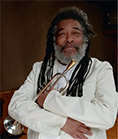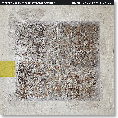THE MUSICIANS

John Tchicai (b. 1936) was born to a Danish mother and a Congolese father in Denmark, where he also grew up. Having started with the violin as a child, Tchicai switched to the alto saxophone and clarinet at the age of 16. He studied both with private teachers and, for two years, at the Conservatory of Music in his hometown of Aarhus in Denmark. Although Tchicai first became known for his work on the alto saxophone, he increasingly began to use the bass clarinet, soprano saxophone, bamboo flutes and percussion in the late 1960s and the early 1970s. Since the early 1980s, the tenor saxophone has been his principal instrument.
 During the late 1950s and early 1960s, Tchicai explored the Danish and Northern European jazz scene enjoying access to Copenhagen´s active club scene, including early visits by Albert Ayler and the Cecil Taylor Trio (with Jimmy Lyons and Sunny Murray). After meeting with trumpeter Bill Dixon and saxophonist Archie Shepp during a socialist youth festival in Helsinki, Finland, Tchicai moved to New York City in 1962 at their suggestion. During his four years in New York City, Tchicai participated in some of the most revolutionary recording sessions of the early 1960s, including the recordings by the two groups that he co-founded, the New York Contemporary Five (with Don Cherry, Archie Shepp, Don Moore and J. C. Moses) and the New York Art Quartet (with Roswell Rudd, Lewis Worrell and Milford Graves), as well as recordings by John Coltrane (Ascension, Impulse), Archie Shepp (Four for Trane, Impulse), Albert Ayler (New York Eye and Ear Control, ESP) and the Jazz Composers´ Orchestra (Communication, Fontana). During this time, he was also a member of the Jazz Composers´ Guild.
During the late 1950s and early 1960s, Tchicai explored the Danish and Northern European jazz scene enjoying access to Copenhagen´s active club scene, including early visits by Albert Ayler and the Cecil Taylor Trio (with Jimmy Lyons and Sunny Murray). After meeting with trumpeter Bill Dixon and saxophonist Archie Shepp during a socialist youth festival in Helsinki, Finland, Tchicai moved to New York City in 1962 at their suggestion. During his four years in New York City, Tchicai participated in some of the most revolutionary recording sessions of the early 1960s, including the recordings by the two groups that he co-founded, the New York Contemporary Five (with Don Cherry, Archie Shepp, Don Moore and J. C. Moses) and the New York Art Quartet (with Roswell Rudd, Lewis Worrell and Milford Graves), as well as recordings by John Coltrane (Ascension, Impulse), Archie Shepp (Four for Trane, Impulse), Albert Ayler (New York Eye and Ear Control, ESP) and the Jazz Composers´ Orchestra (Communication, Fontana). During this time, he was also a member of the Jazz Composers´ Guild.
Following his return to Denmark in 1966, Tchicai became a central figure in European avant-garde. Throughout the years, he has performed and recorded with his own groups, including Cadentia Nova Danica, and also frequently collaborated with guitarists Pierre Dørge and Derek Bailey, bassist Johnny Dyani, pianists Misha Mengelberg, Kristian Blak and Cecil Taylor and many others. In the 1970s, Tchicai discovered hatha yoga and meditation which became lifelong focusing points in his spiritual development. He performed less often in this period, but taught in elementary schools, composed and led workshops. By the 1980s, Tchicai had picked up touring and recording internationally again, traveling throughout Europe as well as to India, Japan and Africa, both performing as a sideman and leading his own groups. Tchicai moved to Davis, California, in 1991 and, after a decade there, he now lives in Claira, France.
In 2000, the New York Art Quartet made its celebrated 35th Anniversary Reunion recording and, in recent years, Tchicai has again increasingly recorded both in the United States and in Europe. In 1990, the Danish Ministry of Culture recognized Tchicai´s work by awarding him a lifetime achievement grant and, in 2004, he was given the prestigious Django D´or Award.
Reggie Workman (b. 1937) started his career as a jazz musician in saxophonist Gigi Gryce´s group in 1958, and soon played with Freddy Cole, Red Garland, Roy Haynes and many others. After moving to New York in the early 1960s, he played in John Coltrane´s groups.
In the early 1960s, Workman established his position as one of New York´s leading young bass players performing with Art Blakey, Miles Davis, Freddie Hubbard, Yusef Lateef, Herbie Mann, Thelonious Monk, Lee Morgan, Archie Shepp and several other leading modernists. During the 1960s, Workman recorded  extensively for the Impulse label, including landmark recordings with John Coltrane (Africa/Brass, Live at the Village Vanguard), Yusef Lateef (1984, Psychicemotus, A Flat, G Flat and C), Pharoah Sanders (Karma), Archie Shepp (Four for Trane, Magic of Ju-Ju) and others. In addition, his recordings that are best remembered from this decade include several classic albums for Blue Note Records under the leadership of Art Blakey, Freddie Hubbard, Bobby Hutcherson, Hank Mobley, Lee Morgan, Wayne Shorter and others. Workman also participated in groundbreaking recording sessions by the Archie Shepp/ Bill Dixon Quartet, the New York Art Quartet (with John Tchicai, Roswell Rudd and Milford Graves) and the Jazz Composers´ Orchestra.
extensively for the Impulse label, including landmark recordings with John Coltrane (Africa/Brass, Live at the Village Vanguard), Yusef Lateef (1984, Psychicemotus, A Flat, G Flat and C), Pharoah Sanders (Karma), Archie Shepp (Four for Trane, Magic of Ju-Ju) and others. In addition, his recordings that are best remembered from this decade include several classic albums for Blue Note Records under the leadership of Art Blakey, Freddie Hubbard, Bobby Hutcherson, Hank Mobley, Lee Morgan, Wayne Shorter and others. Workman also participated in groundbreaking recording sessions by the Archie Shepp/ Bill Dixon Quartet, the New York Art Quartet (with John Tchicai, Roswell Rudd and Milford Graves) and the Jazz Composers´ Orchestra.
Following the 1960s, Workman has continued to be known as one of the most important bass players in contemporary jazz, having played and recorded with Cecil Bridgewater, Alice Coltrane, Marilyn Crispell, Billy Harper, Elvin Jones, Oliver Lake, David Murray, Max Roach, Archie Shepp, Horace Tapscott, Charles Tolliver, Mal Waldron and many others.
Particularly since the beginning of the 1980s, Workman has often led his own ensembles and has recorded several albums under his own name. He has frequently composed works for his own groups, various dance projects and other cross-cultural endeavors. Members of the Reggie Workman Ensemble have, at various times, included Don Byron, Andrew Cyrille, Marilyn Crispell, Gerry Hemingway, Oliver Lake, Jeanne Lee, John Purcell and many others. Workman is also a member of Trio 3 (with Oliver Lake and Cyrille), the New York Art Quartet (with John Tchicai, Roswell Rudd, Milford Graves and Amiri Baraka), the New York Jazz Quartet (with James "Blood" Ulmer, John Hicks and Rashied Ali), the Archie Shepp/Roswell Rudd Group (with Grachan Moncur III and Cyrille) and Brew (with Miya Masaoka and Gerry Hemingway). In 2005, Workman also introduced the W.A.R.M. quartet co-led with Sam Rivers, Roscoe Mitchell and Pheeroan akLaff.
Workman has been active in jazz education for over 30 years and is currently a faculty member of the New School for Jazz and Contemporary Music in New York City.
Andrew Cyrille´s (b. 1939) career as a professional musician began in the early 1960s and he is considered one of the most versatile percussionists in modern jazz. Already during his studies (1960-1964, Juilliard and Hartnett School of Music), Cyrille played with numerous well-established jazz musicians, such as Coleman Hawkins, Illinois Jacquet and Mary Lou Williams, and with representatives of modern jazz, such as Bill Barron, Walt Dickerson, Kenny Dorham and Rahsaan Roland Kirk, as well as the Nigerian drummer Babatunde Olatunji.
Cyrille is perhaps best known for his membership in the Cecil Taylor Unit that lasted for over a decade (1964-1975), during which he established his position as one of the leading percussionists in freely improvised jazz. Cyrille´s numerous recordings with Cecil Taylor include two legendary dates (Conquistador and Unit Structures) for Blue Note Records. He also played and recorded with many other leading musicians in modern jazz during this period, including several classic recordings with vibraphonist Walt Dickerson.
Since the 1970s, Cyrille has led or co-led various ensembles, including Maono (with David S. Ware, Ted Daniel et.al.), The Group (with Ahmed Abdullah, Marion Brown, Billy Bang and Fred Hopkins ) and the percussion quartet Pieces of Time (with Kenny Clarke, Don Moye and Milford Graves). He has released more than 30 recordings as a leader or co-leader ranging from solo recordings and a number of duo recordings to larger ensembles. Cyrille has also performed and recorded with Muhal Richard Abrams, Geri Allen, Billy Bang, Anthony Braxton, Charles Brackeen, Dave Burrell, John Carter, Marilyn Crispell, Oliver Lake, David Murray, Roswell Rudd, Archie Shepp, Horace Tapscott and many other leading names in contemporary jazz. Currently, he continues to record and perform with various duo, trio, quartet, quintet and big band formations. He leads the Haitian Fascination ensemble (with Hamiet Bluiett, Alix "Tit" Pascal, Lisle Alkinsson and Frisner Augustin), playing music inspired by the musical tradition of Haiti, is a member of Trio 3 (with Oliver Lake and Reggie Workman), the CDE Trio (with Marty Ehrlich and Mark Dresser), the Roswell Rudd/Archie Shepp Group and a number of other ensembles and performs as a duo with saxophonists Anthony Braxton (Duo Palindrome 2002, Vol. 1 & Vol. 2, Intakt) and Greg Osby (Low Blue Flame, TUM CD 016).
) and the percussion quartet Pieces of Time (with Kenny Clarke, Don Moye and Milford Graves). He has released more than 30 recordings as a leader or co-leader ranging from solo recordings and a number of duo recordings to larger ensembles. Cyrille has also performed and recorded with Muhal Richard Abrams, Geri Allen, Billy Bang, Anthony Braxton, Charles Brackeen, Dave Burrell, John Carter, Marilyn Crispell, Oliver Lake, David Murray, Roswell Rudd, Archie Shepp, Horace Tapscott and many other leading names in contemporary jazz. Currently, he continues to record and perform with various duo, trio, quartet, quintet and big band formations. He leads the Haitian Fascination ensemble (with Hamiet Bluiett, Alix "Tit" Pascal, Lisle Alkinsson and Frisner Augustin), playing music inspired by the musical tradition of Haiti, is a member of Trio 3 (with Oliver Lake and Reggie Workman), the CDE Trio (with Marty Ehrlich and Mark Dresser), the Roswell Rudd/Archie Shepp Group and a number of other ensembles and performs as a duo with saxophonists Anthony Braxton (Duo Palindrome 2002, Vol. 1 & Vol. 2, Intakt) and Greg Osby (Low Blue Flame, TUM CD 016).
Cyrille has been involved in jazz education since the early 1970s and is currently a faculty member of the New School for Jazz and Contemporary Music in New York City.







